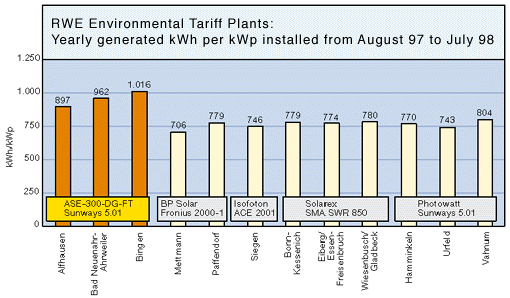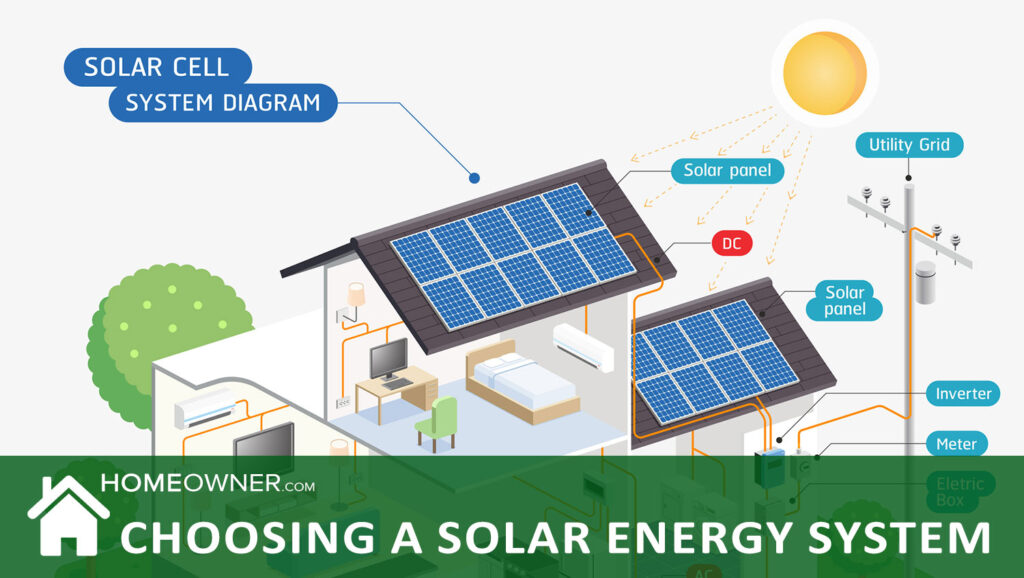Many readers ask us, ‘How does solar energy work?' The answer has to do primarily with photovoltaic solar cells. Hundreds of solar cells (also called photovoltaic cells) make up a solar photovoltaic (PV) array. Solar cells are the components of a solar system that converts radiant light from the sun into electricity, that is then used to power solar energy in your home.
Solar cells are often referred to as “photovoltaic solar cells.” This is because the word “photo” comes from the Greek word for “light,” and the word “voltaic” refers to electricity pioneer Alessandro Volta.
Get A FREE Home Solar Quote Now
7 Common Types of Solar Cells
- Silicon Solar Cells
- Monocrystalline Silicon Solar Cells
- Polycrystalline Solar Cells
- Thin Film Solar Cells
- Amorphous Silicon Solar Cells
- Cadmium Telluride Solar Cells
- Copper Indium Gallium Selenide Solar Cells
Solar cells contain materials with semiconducting properties in which their electrons become excited and turned into an electrical current when struck by sunlight. While there are dozens of variations of solar cells, the two most common types are those made of crystalline silicon (both monocrystalline and polycrystalline) and those made with what is called thin film technology.
1. Silicon Solar Cells
The majority of the solar cells on the market today are made of some type of silicon – by some estimates, 90% of all solar cells are made of silicon. However, silicon can take many different forms. Variations are most distinguished by the purity of the silicon, which refers to the way the silicon modules are aligned.
The greater the purity of the silicon molecules, the more efficient the solar cell is at converting sunlight into electricity. The majority of silicon-based solar cells on the market – about 95% – are made of crystalline silicon, making this the most common type of solar cell. But there are two types of crystalline: monocrystalline and polycrystalline.
2. Monocrystalline Silicon Solar Cells
Monocrystalline solar cells, also called “single crystalline” cells are easily recognizable by their coloring. But what makes them most unique is that they are considered to be made from a very pure type of silicon.
In the silicon world, the more pure the alignment of the molecules, the more efficient the material is at converting sunlight into electricity. In fact, monocrystalline solar cells are the most efficient of all; efficiencies have been documented at upwards of 20%.
Monocrystalline solar cells are made out of “silicon ingots,” a cylindrically shaped design that helps optimize performance. Essentially, designers cut four sides out of cylindrical ingots to make the silicon wafers that make up the monocrystalline panels. In this way, panels comprised of monocrystalline cells have rounded edges rather than being square, like other types of solar cells.
Beyond being most efficient in their output of electrical power, monocrystalline solar cells are also the most space-efficient. This is logical since you would need fewer cells per unit of electrical output. In this way, solar arrays made up of monocrystalline take up the least amount of space relative to their generation intensity.
Another advantage of monocrystalline cells is that they also last the longest of all types. Many manufacturers offer warranties of up to 25 years on these types of PV systems.
The superiority of the monocrystalline cells comes with a price tag. In fact, solar panels made of monocrystalline cells are the most expensive of all solar cells, so from an investment standpoint, polycrystalline and thin film cells are often the preferred choice for consumers. One of the reasons monocrystalline cells are so expensive is that the four-sided cutting process ends up wasting a lot of silicon, sometimes more than half.
3. Polycrystalline Solar Cells
Polycrystalline solar cells, also known as polysilicon and multi-silicon cells, were the first solar cells ever introduced to the industry, in 1981. Polycrystalline cells do not go through the cutting process used for monocrystalline cells. Instead, the silicon is melted and poured into a square mold, hence the square shape of polycrystalline. In this way, they're much more affordable since hardly any silicon is wasted during the manufacturing process.
However, polycrystalline is less efficient than its monocrystalline cousin. Typically, polycrystalline solar PV systems operate at a 13-16% efficiency – again, this is because the material has a lower purity. Due to this reality, polycrystalline is less space-efficient, as well. One other drawback of polycrystalline is that it has a lower heat tolerance than monocrystalline, which means they don't perform as efficiently in high temperatures.
4. Thin Film Solar Cells
Another up and coming type of solar cell is the thin film solar cell with growth rates of around 60% between 2002 to 2007. By 2011, the thin film solar cell industry represented approximately 5% of all cells on the market.
While many variations of thin film products exist, they typically achieve efficiencies of 7-13%. However, a lot of research and development is being put into thin film technologies and many scientists suspect efficiencies to climb as high as 16% in coming models.
Thin film solar cells are characterized by the various types of semiconducting materials (including silicon in some cases) that are layered on top of one another to create a series of thin films.
The major draw of thin film technologies is their cost. Mass production is much easier than crystalline-based modules, so the cost of mass producing thin film solar cells is relatively cheap. The product itself is also flexible, which is leading to many new applications of solar technologies in scenarios where having some type of flexible material is advantageous.
One major drawback is that thin film technologies require a lot of space. This makes them less of an ideal candidate for residential applications where space becomes an issue. As a result, thin film is taking off more in the commercial space. And thin film solar cells have a shorter shelf life than their crystalline counterparts, as evidenced by the shorter warranties offered by manufacturers.
Thin film technology uses various photovoltaic substances, including amorphous silicon, cadmium telluride, copper indium, and gallium selenide. Each type of material is suitable for different types of solar applications.
5. Amorphous Silicon Solar Cells
Thin film solar cells made out of amorphous silicon are traditionally used for smaller-scale applications, including things like pocket calculators, travel lights, and camping gear used in remote locations. A new process called “stacking” that involves creating multiple layers of amorphous silicon cells has resulted in higher rates of efficiency (up to 8%) for these technologies; however, it's still fairly expensive.
6. Cadmium Telluride Solar Cells
Cadmium Telluride is the only thin-film material that has been cost-competitive with crystalline silicon models. In fact, in recent years, some cadmium models have surpassed them in terms of their cost-effectiveness. Efficiency levels result in a range of 9-11%.
7. Copper Indium Gallium Selenide Solar Cells
Copper Indium Gallium Selenide cells have demonstrated the most promise with respect to their efficiency levels that range from 10-12%, somewhat comparable to crystalline technologies. However, these cells are still in the nascent stages of research and have not been commercially deployed on any wide scale. That said, the technology is mostly used in larger or commercial applications.
PV Solar Cell Construction
Solar cells are constructed of an upper layer of silicone containing negatively charged electrons (n-type) and a bottom layer of silicone containing positively charged electrons (p-type).
When the sun's light (photons) hit these photovoltaic solar cells, electrons are released from the bottom layer of silicone and jump across to the upper layer of silicone causing current to flow and thus creating energy.
The more light that shines on these cells, the more electrons that jump up and the more energy that is produced. This is how solar cells work to continuously produce energy, but only when exposed to light.
How To Test PV Solar Cells
Testing PV cells to make sure they're working properly. Always follow the solar safety guidelines when working with electricity.
Procedure For Testing Solar Cells
To test solar cells, you will need to place your solar cells in direct sunlight and use a multimeter that measures both Voltage and Amperage.
Testing For Volts
To test solar cells for the volts reading, make sure the multimeter is shut off. Plug the black (-) lead into the black port and the red (+) lead into the V (voltage) port.
Turn on the multimeter. Set the dial of the multimeter to the volt position.
Put your solar cell down on a clean work area (preferably a block of wood) with the positive side facing up. (That's the side without the tabs attached – facing up).
- Touch the multimeter black lead to the solar panel's negative contact (which is the tab wire coming from the underside of the solar cell.
- Touch the red lead to the solar cell's positive contact (which is any contact point on the positive side of the cell).
Your voltage reading for a 1.75 watt solar cell should be about 0.5 volts. If the reading is much less, then this solar cell is most likely defective and you should not use it in your solar panel. If you are testing solar cells that are bigger, than your readings should obviously be bigger.
Testing For Amps
To test solar cells for the amp reading, make sure the multimeter is shut off. Plug the black (-) lead into the black port and the red (+) lead into the A (amps) port.
Turn on the multimeter. Set the dial of the multimeter to the amps position.
Put the solar cell down on a clean work area (preferably a block of wood) with the positive side facing up. (That's the side without the tabs attached – facing up).
- Touch the multimeter black lead to the solar panel's negative contact (which is the tab wire coming from the underside of the solar cell).
- Touch the red lead to the solar cell's positive contact (which is any contact point on the positive side of cell).
Your amperage reading for a 1.75 watt solar cell should be about 3.5 amps. If the reading is much less, then this solar cell is most likely defective and you should not use it in your solar panel.
So if you are using the same solar cells as we do in our examples, your volt, amp, and watt readings should be just under: 0.5 volts, 3.5 amps, and 1.75 watts.
Great, this solar cell is working correctly and can be used in your solar panel!
What Are Solar Cells Made Of?
Solar cells are (more or less) what solar panels are made of. They are those small rectangular (or octagonal) shapes you see on the face of a solar panel.
Photovoltaic solar cells are flat rectangular (or octagonal) shaped pieces of silicone (commonly made from sand). They are usually a bluish-black color and have tiny wires running through them.
Silicone is what's known as a “semiconductor.” This means it can conduct electricity, but only under certain conditions. In this case, these conditions are “exposure to the radiant energy that exists in sunlight.”
Photovoltaic (PV) cells
Photovoltaic (PV) cells made their debut in 1958 when they were launched into outer space onboard the Vanguard Satellite. The PV cells proved so reliable that they have been an intricate part of powering our telecommunications industry ever since.
One of the many benefits of manufacturing solar cells is that their basic building block is centered around silicon, one of the most abundant elements on earth. Silicon is also the main substance found in beach sand.
The enormous growth in the world economy, reflecting both increase in population and rising affluence, is occurring on a planet that is no larger today than it was when we evolved some 4 million years ago.
Yet the consequences of increasing human demands on the natural systems and resources such as our fossil fuels of a finite planet are being felt in every country around the world. Photovoltaics offer an alternative means of producing essential electric power without further endangering the delicate balance of our fragile ecosystems.
Rising carbon emissions were once favorably looked upon as a measure of economic growth and development. Estimated at 93 million tons in 1860, emissions jumped to 525 million tons by 1900, and to 1.62 billion tons by 1950. At the end of 1994, the atmosphere contained 4 billion more tons of carbon than just 12 months earlier.
Today's fastest rise in CO2 emissions occurs in the rapidly developing nations of Asia and Latin America. Though developing countries emit only 0.5 tons of carbon per person (compared with 3.0 tons per person in industrial countries and 20 tons per person in the U.S.), they already account for a third of the global total. Their contribution is growing fast enough to double every 4 years.
Commentary
Following is a commentary discussing how restructuring in the electric power industry will be changing our society and the growing role photovoltaics will play in this new frontier.
Energy is the lifeblood of our modern day society. Without it, we wouldn’t have the transportation, manufacturing, communication, and many other elements that support the complex lives we lead. Part and parcel with energy is electricity.
Electricity now provides us with everything from heat for our homes to power for our appliances, communications, and computational capabilities. Energy and electricity are as vital to our modern society as food is to our bodies. Similar to the way food keeps our bodies running, electricity allows society to operate.
We pay different prices for different food. Some foods we eat because they taste good, other foods we eat because we know they are nutritious. Some food is important to us in its presentation and aesthetics and other food is simply for sustenance. It may seem reasonable to pay $35.00 for a lobster dinner in an elegant setting but we would be much less willing to pay the same amount for a plate of spaghetti at a diner. After all, we as humans place different values on all types of products and services depending on market forces and perceived quality.
This concept has not held true for electricity in the U.S. because it has been a regulated monopolistic industry. This is changing as the era of deregulated electric power looms before us.
In the past, our society has depended on relatively few power sources that have been cheap and abundant, like a diet of hamburgers only. These energy sources such as oil and coal are limited and come with unaccounted costs (pollution, acid rain, global warming, Desert Storm).
New technologies combined with a restructuring of the electric power industry have the potential to improve the fare. We as individuals can begin in earnest to incorporate energy sources into our diet that are more healthy and beneficial to society. Similar to satisfying our palate with both caviar and hamburgers, we each should diversify our energy consumption as well.
Photovoltaics (Solar Electricity) is just the advanced technology to improve our diet. It is based on silicon semiconductors, just like the integrated chip in our computers. There are no moving parts, no combustion of fossil fuel to create noise, nor exhaust emissions. Photovoltaic cells simply create electricity when the sun is up.
Dramatic price reductions have already been demonstrated with increasing volume. With even greater demand, the price of photovoltaics will continue to drop. Electric power deregulation and further advancements will make the technology easy to use and more accessible.
You can choose the food you eat, but you have had little choice in your environment (aside from moving). It's time to start putting some photovoltaics on your menu. Your local utility company may have a new program for photovoltaics.
Excellent Energy Yields From ASE-300 Photovoltaic Modules
When discussing prices, an essential point is often ignored: How do the modules perform in reality?
Although different modules may have equal power ratings (at STC = Standard Test Conditions, Irradiation on module surface 1000W/m² with spectrum AM 1.5 and cell temperature 25°C), they can differ substantially in their energy yield.
By comparative monitoring of various photovoltaic installations, it has been shown that systems based on large-area modules of the type ASE-300 achieve exceptionally high yields in energy.
This fact is particularly obvious in the RWE Environmental Tariff program. Within the scope of this program, 25 photovoltaic installations with a total power of more than 1 MWp have been built by different manufacturers.
The energy yields of the installed systems are continually recorded and the data is available. The following graph shows the annual amount of kWh fed into the grid with respect to the kWp, the installed rated power of the generator.
All the grid-tie installations in operation since August 1997 have been incorporated in this comparison. Photovoltaic installations based on the ASE-300 are distributed through the entire electric utility region of RWE and, therefore, are located at sites with higher as well as lower solar irradiation.

The above chart illustrates that installations based on ASE-300 modules achieve energy yields that are approximately 20 to 25 % higher than average. Taking into account the higher efficiency of the inverter (Sunways) used here, we can expect the performance of the modules to be 15 to 20 % higher.
The outstanding performance of the ASE-300 module is a result of:
- Performance measurements based on international standards (3 % more than the 1997 module based on ESTI/ISPRA standards).
- Large modules with 216 closely selected cells resulting in installations with fewer modules and wiring losses.
- Minimized deviation of nominal power (± 4 %) through serial connection resulting in lower mismatch losses.
- Multi-Contact plugs that allow fast installation as well as safe low-loss connection.
- The large ASE-300 module (2.4 m²) also reduces support structure costs and installation time.
Remember these advantages when you compare prices!
Safety – The Highest Possible Fire Protection
Solar electric (photovoltaic) systems are increasingly finding their way onto rooftops across the United States. Fortunately, the solar industry in general and RWE SCHOTT Solar in specific have been working with related standards to ensure that the photovoltaic (PV) systems are safe.
ASE's PV modules are fully covered by Underwriters' Laboratories UL 1703 (Flat-Plate Photovoltaic Modules and Panels) – standard for the PV modules – and the Institute for Electrical and Electronics Engineers IEEE 1262 (Recommended Practice for Qualification of Photovoltaic Modules) for performance and reliability.
UL 1741 (Static Inverters and Charge Controllers for Use in Photovoltaic Power Systems) is the proposed standard for PV inverters (the devices that convert the DC from the Module to the AC of the grid). The electrical systems should comply with National Electric Code NEC article 690 and the structural designs should comply with the Uniform Building Code (UBC). There are a number of commercially available products and system designs from the PV industry that comply with most of these standards.
Fire is a major concern among building inspectors. PV modules placed on roofs are required to carry the same, or higher, UL fire rating as the roofing material itself. There are three classes of rated roofing, Classes A through C; Class A being the highest rating. Therefore, Class C roofs only require modules with Class C or higher. Class B roofs can carry Class B and higher and so on. It's our understanding that, according to the Uniform Building Code, most commercial roofs in the U.S. should use Class B or higher roofing material.
Selecting the Right Solar Photovoltaic System
There is not a “one size fits all” solar photovoltaic (PV) system. In fact, solar PV arrays can vary considerably both in their general design, size, and application. That is why it's important for consumers to clearly understand what they're looking for when shopping for a solar array. The two biggest considerations that consumers should take into account when selecting their solar PV system are related to the size of their system and what type of solar cell it has.
Right-Sizing a Solar PV System
Selecting the right solar PV system can be everything from an investment standpoint – too small of a solar system and buyers, energy demands aren't met, too large of a system and buyers will overspend on a system that generates too much power and potentially fails to generate a return on their investment. So what should consumers do in order to get it right and select a solar PV system that meets their needs?
The first step consumers should take is to identify how much electricity they need or want their system to generate. Contractors may try to sell buyers as much generation capacity as will fit on their roofs, but buying too large (and expensive) of a system is one of the biggest pitfalls a consumer can make.
Some consumers may actually want to purchase an array that will cover their entire roof. This option is most suitable for consumers who want to take advantage of net metering policies. Net metering policies are utility rates that enable home and business owners to actually sell excess electricity generated by their solar PV system back to their utility company at an agreed upon rate.
Typically, the rate is equal to what they pay per unit of electricity. In this way, the solar PV investment will not only meet some household energy demands, but also serve as an income generator for the solar PV owner. It's important to keep in mind that installing solar PV panels everywhere may not be effective since panels must be properly positioned to capture sunlight and kept out of any areas where there are obstructions or shade.
Rather than fill their entire rooftop, most consumers will want to purchase a system that offsets all or a portion of their electric bill. According to the United States Energy Information Administration (EIA), in 2011, the average American household used approximately 11,300 kilowatt hours (kWh) of electricity per year.
However, since there are many factors that can make energy usage much higher or lower than that – building size, climate, heating, and cooling type, number of luxury appliances, etc. – the best way to determine a home's unique energy demand is to review recent utility bills for that household. If consumers don't have their bills on file, they can also request this analysis from their utility company.
Electricity is typically measured in kilowatt hours. The first step is to find out what the household's annual kWh usage is. Since electric consumption may vary by season, it's important to look at an entire year's worth of bill payments to understand the ebbs and flows in electric demand from month to month and season to season.
For instance, consumers with electric air conditioning units may see huge spikes in electricity demand during warmer months whereas those in cooler climates with electric heating may have different demand patterns.
Another major factor affecting energy usage is consumer behavior. Changes in the number of occupants in a household can cause electricity usage to go up or down, since more people increase water and appliance usage. Whatever the case, consumers should determine what their peak demand for energy usage is – peak energy usage is the amount of energy that the household consumes at the highest point throughout the year. Utility companies can send this data to customers if they have not kept their utility bill statements on file.
Beyond overall demand, consumers will also want to consider what times of day they actually use the most power – morning, midday, or evening. This is important because solar PV systems only generate power during daylight hours. The only exception to this is if a homeowner has or wants to invest in some type of energy storage system that enables them to use electricity generated from their solar PV system at any time of day.
However, assuming a standard solar PV system without energy storage, buyers should identify what their electricity demand is during daylight hours so they can select a system that meets their demand during these hours. Daylight hours will vary by geographical location and even by season so consumers should understand local conditions. There are many websites online that can provide information about average daylight hours and changes in daylight hours by geographic location.
As a general rule of thumb, the cost per kilowatt hour of a system goes down slightly as it increases in size, so consumers should also take this into account. This is largely because inverters – an essential component of a solar PV system package that converts the electricity to the right type of current – are often sized to accommodate a solar PV system that is larger than, say 5 kW.
In this way, the same inverter is often used for smaller systems, such as a 3 kW system – so the costs for the inverter might be slightly more for the smaller model. This is something to factor in when considering the size of a system to buy.
Selecting the Right Solar Cell
Another major consideration is what type of solar cell you want within your PV system since different modules generate different levels of electricity per square foot than others.
At a very basic level, monocrystalline silicon systems have traditionally been known for being the most efficient type of solar cell – generating the most electricity relative to size; however, they are also the most expensive. Polycrystalline silicon cells are less efficient than monocrystalline arrays, but they're also less costly. And they are a particularly good choice for climates that have more overcast days.
Finally, thin film technologies are also a new option becoming increasingly popular – they're typically as efficient as polycrystalline models and are very cost-competitive. And with lots of research and development being put towards thin film technology, this type of solar cell is likely to drop in cost even further in future years.
How Solar Cells Work To Power Your Home
Solar cells work by capturing the sun's radiant energy and turning it into DC (direct current) electricity we can use in our homes. When a solar panel is making energy, it's really the solar cells doing all the hard work.
Solar cells collect and convert energy from the atmosphere. By using wires, the energy occurring in the solar cell is then led to a circuit and utilized to power appliances, electronics, or anything else that runs on electricity.
Since each solar cell produces a few volts of electricity, connecting many solar cells together can multiply the power generated by the number of cells used. The entire collection of photovoltaic solar cells constitutes a solar panel.
Solar panels are then connected in a similar way to multiply (increase) the energy production even more or to the desired level of current and voltage sufficient to power household loads.
Although one cell only produces a tiny (but usable) amount of power, joining many together can potentially power your entire home, your whole block, and even entire cities.
The best way for consumers to determine what solar PV system is right for them is to hire a solar installer who is cross-trained in solar PV. These professionals can provide a detailed assessment of a household's energy usage and offer tips that are tailored to the consumers' individual needs. Some people choose to do their own DIY solar installation and you can even build your own solar panels. Sometimes, you can find free solar panels that only need minor repair.
Energy audits typically cost just a few hundred dollars. And many utility companies or state energy offices now offer rebates that cover some or all of the costs of energy audits – this level of analysis can give consumers the answers they need when selecting the right size and type of solar PV system to buy.





